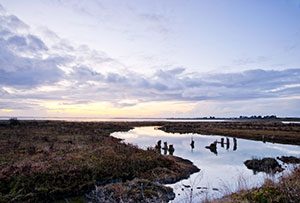South Humboldt Bay

Humboldt Bay – photo copyright Humboldt State University
The South Humboldt Bay State Marine Recreational Management Area spans a small area of the Humboldt Bay. Its western border lies against the contours of the inner South Spit. Humboldt Bay is California’s second largest natural bay and is a nationally significant area for migratory birds. Most of the ecology is characterized by intertidal mudflats, and eelgrass beds that host a diversity of species both above and underwater.
Interesting Facts:
- There is a lot of biodiversity to go around here. It is estimated that over 100 species of fish, 50 species of mammals, and 260 species of birds make the South Humboldt Bay their home.
- This estuary is the largest producer of oysters on the West coast. The Kumamoto oysters produced in Humboldt Bay are often considered the best in the United States.
- Indian Island, located in the middle of the Humboldt Bay, is an important cultural and heritage site for the Wiyot people, a Native American tribe that has lived around the Humboldt Bay for more than a thousand years. The island was home to two ancient villages; Tuluwat and Etpidolh. At Tuluwat, the Wiyot hold an annual “world renewal ceremony,” a dance lasting seven to ten days.
- The southern section of Humboldt Bay holds 2,000 acres of eelgrass beds. This is important because many of the migratory birds enjoy eating this grass, it can act as a nursery ground for young fish, help filter water, and over 90% of the eelgrass beds in the United States have been destroyed, making the existing beds a rare commodity. To read more about eelgrass, check out this webpage: http://www.habitat.noaa.gov/abouthabitat/eelgrass.html
Recreation Opportunities:
- Go bird watching! Myriads of migratory birds make this bay a pit stop on their route to rest and forage on eel grass that is still abundant here. On average, more than 100,000 birds land in the Bay each season.
- Go see the iconic Woodley Island—home to the Table Bluff lighthouse and “The Fisherman”, a statue commemorating all the lives lost at sea
- Stop by the Humboldt Bay National Wildlife Refuge to see the visitor center, go on hikes, and spot even more wildlife. See more information at their website: http://www.fws.gov/refuge/Humboldt_Bay/visit/visitor_activities.html
- Kayak in and around the marine protected area. This can often get you the best views of this estuary and its great diversity of fish, plants, birds, and more. For detailed instructions on how to kayak to South Humboldt Bay SMRMA, see here: http://redwoods.info/showrecord.asp?id=5766


